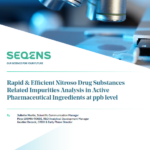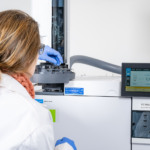
Rapid & Efficient Nitroso Drug Substances Related Impurities Analysis in APIs at ppb levels
Nitrosamines are a group of organic compounds containing the nitroso functional group. They can be found in water, food, tobacco, pesticides, or plastics, but received public attention in mid-2018, when they were also found in health products.
Nitrosamines are known as possible mutagenic carcinogens for humans. They are referred to as the “cohort of concern” by the International Council for Harmonisation of Technical Requirements for Pharmaceuticals for Human Use (ICH) guidance on assessment and control of DNA reactive (mutagenic) impurities in pharmaceuticals to limit potential carcinogenic risk1. The two best-known nitrosamines, N-nitrosodimethylamine (NDMA) and N-nitrosodiethylamine (NDEA), have been classified by the International Agency for Research on Cancer (IARC) as possible human (class 2A) carcinogens, but they are also genotoxic2 . Once N-nitrosamines are activated by microsomal liver enzymes, they can react with DNA base pairs to form unstable α-hydroxyalkylnitrosamines and produce alkyldiazonium ions, which alkylate DNA bases and induce carcinogenic response3 .
Their presence in active substances may be linked to several factors, such as processing conditions with raw materials impurities like nitrite, accidental introduction due to cross-contamination (due to processes running in parallel on the same production lines), recovery procedures for solvents or also from degradation of the substance.
In addition to a list of nitrosamines classified with their specific maximum daily intake, all other nitrosamines such as Nitroso Drug Substances Related Impurities (NDSRI’s) should be identified and quantified in Active Pharmaceuticals Ingredients and Drug Products based on the risk evaluation. Further to the identification, the toxicological characterization of the Nitroso Drug Substances Related Impurities should be performed.
In this white paper, we review the main analytical techniques that have been investigated, and then we will present our work, lead at our SEQENS’Lab , regarding the development of a UPLC-HRMS (ultra-high-performance liquid chromatography-high resolution mass spectrometry) technique for identifying and quantifying Nitroso Drug Substances Related Impurities, at ppb (parts-per-billion) levels in Active Pharmaceutical Ingredients.
Discover our Analytical Solutions
Introduction
Five years ago, the nitrosamine crisis began with a contamination issue in valsartan, a drug substance from a Chinese manufacturer, discovered on June 20, 2018. The contamination involved N‐nitrosodimethylamine (NDMA). Initially, there was limited knowledge about the problem’s extent and NDMA levels, as stated by the European Medicines Agency (EMA)2. However, immediate regulatory actions prompted a global risk assessment process. Within weeks, more nitrosamines were found in various active pharmaceutical ingredients (APIs).
Ten months after the first nitrosamine detection, approximately 22% of tested API batches and 18% of drug product batches containing valsartan, losartan, and irbesartan exceeded acceptable limits for NDMA, N‐nitrosodiethylamine (NDEA), and/or N‐nitroso‐N‐methyl‐4‐aminobutyric acid (NMBA) in the European Union. Over 1800 drug product batches, including sartans, antidiabetic drugs, antihistamines, and antibiotics, were recalled in the United States due to nitrosamine detection. The U.S. Food and Drug Administration (FDA) and the European Medicines Agency (EMA) also initiated a complete withdrawal of ranitidine and varenicline drug products from the market due to the inability to eliminate N-nitrosamines contamination.
Analytical measurements were deemed crucial for detection and control, given that nitrosamines are mutagenic and carcinogenic. Lists of nine potential known nitrosamines were established with interim intake limits based on toxicity5. This discovery, like N-nitrosovarenicline, highlighted the potential for nitrosation in APIs and other drug ingredients.
The European Medicines Agency (EMA) introduced a multi-step approach for regulatory referral, including evaluation (step 1), confirmatory testing (step 2), and risk mitigation (step 3) if nitrosamines are detected or likely. A new scenario was introduced in step 2, addressing cases where new nitrosamines are found in unassessed medicinal products, expanding beyond the original nine nitrosamines.
Recently, it was shown that up to 40% of common APIs and 30% of API impurities are potential N-nitrosamines precursors, as they contain vulnerable amine moieties.
If only the more reactive secondary amines are considered, still 13−15% of APIs are potentially at risk. As a consequence, and unsurprisingly, Nitroso Drug Substances Related Impurities (NDSRIs) have become the focus from both an industry and regulatory perspective.
Request our webinar to learn how to deal with the new guidance during Drug Product Development
The main sources of nitrosamines were previously linked to sodium nitrite use or carryover in API synthesis and drug product manufacturing. Furthermore, concerns also arose from recycled or contaminated materials, cross-contamination of nitrosamine intermediates, degradation processes, and the use of specific packaging materials (eg. nitrocellulose lidding foil) or nitrosating agents in the presence of secondary or tertiary amines.
Recent findings have highlighted the role of organic solvents and short-chain aliphatic amines (e.g., dimethylamine, diethylamine, or N‐methyl‐2‐pyrrolidone) as potential precursors of nitrosamines.
The potential for nitrosamine formation hasn’t been fully explored, as nitrosation studies are not mandatory during drug development, registration, or forced degradation studies.
Analytical methods capable of detecting nitrosamines impurities at very low levels.
The demand for highly sensitive and specific analytical methods with LOQs (Limit of Quantification) in the ppm and sub-ppm ranges is among the most significant challenges facing analytical scientists. In addition, artifactual nitrosamine formation during sample preparation and injection leading to overestimation of nitrosamines presence has received considerable attention.
Download our white paper below to learn more about nitrosamine detection
References
[2] European Medicines Agency (EMA). Lessons learnt from presence of N-nitrosamine impurities in sartan medicines [displayed 24 September 2020]. Available at https://www.ema.europa.eu/en/documents/report/lessons-learnt-presencen-nitrosamine-impurities-sartan-medicines_en.pdf

